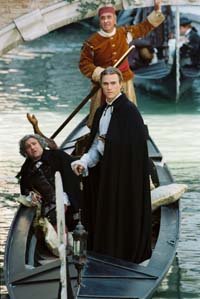
One of the QANTAS in-flight movies I watched while enroute to Sydney from Los Angeles was Lasse Hallstrom’s Casanova, starring Heath Ledger.
I was drawn to this movie primarily because it was filmed in Venice – the city I most admired and enjoyed when in Europe last year.

The villain of this decidedly lightweight retelling of the legend of the famed Venetian lover, is a Vatican inquisitor played by Jeremy Irons. Watching the antics of this particular character brought to mind numerous other films that feature (often much more realistic) characterizations of cruel and despotic Vatican officials. I was also reminded of how some Catholics find such portrayals highly offensive – a reaction which, to be honest, I’ve always found rather perplexing. Don’t these people know the history of their own Church?
True, it’s not been all bad. The Catholic Church has been responsible for great good in people’s lives. Yet this has more often than not been in spite of, not because of leadership from the Vatican.
A work of “critical loyalty”
One of the best books I can recommend for a comprehensive yet succinct overview of the history of Catholicism is Hans Küng’s The Catholic Church: A Short History.
Publishers’ Weekly notes that “woven through Küng’s mostly readable account is a consistent call for the abolition of the doctrine of papal infallibility, one of the stances that got him into trouble with church authorities two decades ago. Küng also uses his book to criticize the church's present efforts to safeguard its teachings through the Congregation for the Doctrine of the Faith. His 1979 censure, he says, was a ‘personal experience of the Inquisition,’ yet he claims to remain faithful to the church in what he calls ‘critical loyalty.’”
In the book’s introduction Küng makes it clear that he has written his history of the church as someone involved in it. By his own acknowledgement, he “takes the side of those who became victims.” Despite this, Küng maintains that “personal commitment and matter-of-fact objectivity can as well be combined in a history of the church as they can in the history of a nation.”
Küng observes that the Catholic Church is “a controversial church, subject to extremes of admiration and attack.” He notes that “beyond question,” the Catholic Church is a history of success: It’s the oldest, numerically the strongest, and probably also the most powerful representative of Christianity in the world. Aspects of it are greatly admired.
He also notes that the standing of the church has declined since the time of the Second Vatican Council – resulting in it “being attacked more than ever in some quarters.”
He also concedes that the church is largely itself responsible for this decline, noting that “scarcely any of the great institutions in our democratic age deal in such a despicable way with critics and those of other views in their own ranks, nor does any discriminate so much against women – by prohibiting contraceptives, the marriage of priests, and the ordination of women. None polarizes society and politics worldwide to such a degree by rigid positions in matters of abortion, homosexuality, and euthanasia, positions always invested with an aura of infallibility, as if they were the will of God himself.”
Concludes Küng: “In view of the apparent inability on the part of the Catholic Church to correct and reform itself, is it not understandable that at the beginning of the third Christian millennium the more or less benevolent indifference widely shown to the church around fifty years ago has turned into hatred, indeed public hostility?”
Two extremes
Küng describes two extremes when it comes to viewing and understanding the history of the church. One of these sees the church as a great tree, which, while continuing to bear rotting fruit and to put forth dead branches, can still be understood to be in a process of permanent development, unfolding and becoming perfect.
At the other end of the spectrum is the opinion that in the church’s 2000-year history no organic process of maturing can be detected, but rather something more like a criminal history.
In response to the first extreme, Küng poses the following question: “Supposing that there is organic growth, are there not also within the history of the Catholic Church quite unorganic, abnormal, completely nonsensical, false developments, for which the church’s official representatives are themselves responsible? Despite all the grandiose talk of progress, all in all are there not also terrifying lapses, for which the popes are anything but blameless?”
In response to the second extreme, Küng asks: “Does a fixation on the negative side do justice to the history of the Catholic Church?” He also observes that “Those who deliberately step in all the puddles should not complain too loudly about how bad the road is.”
For Küng, “neither an idealizing and romanticized history of the church nor one filled with hatred and denunciation can be taken seriously. Something else is called for.” He is adamant that like the history of any institution, the history of the Catholic Church is a checkered one, and that in the final analysis, any theology must, insofar as it claims to be Christian, ultimately be judged by the criterion of what is Christian.
And what is the criterion of what is Christian? According to Küng it’s “the original Christian message, the gospel, indeed the original figure of Christianity: the concrete, historical Jesus of Nazareth, who for Christians is the Messiah.”
Infallibility
Some have observed that the book is “more a critical history of the papacy, i.e., the church as institution, rather than a history of the church as the People of God. Steve Harris at Amazon.com, for instance, notes that Küng’s book is a “diamond sharp assault on the papacy as it currently exists. And the bull's eye is infallibility.”
“After reading Kung's argument," says Harris, "I come away thinking there is simply no intellectual or spiritual leg on which to support this doctrine. To support it is to deny having a brain, and arguably, a soul. A good exercise after reading [Küng’s book] would be to run to The Brothers Karamazov, and read ‘The Grand Inquisitor’ chapter. Dostoevksy could see through the murk of argument, to the spiritual heart of the matter. With the insistence on infallibility, there can be no Christ, in fact, it insures ultimately, a rejection of Christ.”
Harsh words, indeed. But not that far removed from those of Pope John XXII who, in 1324 (when the idea of papal infallibility and the irreformability of papal decisions was first propagated by an eccentric Franciscan, Petrus Olivi), condemned it as the work of the devil, “the father of all lies.” It wasn’t until the late nineteenth century, Küng reminds us, that the idea was “warmed up again . . . by conservative publicists and popes.” (p.121).
An “age of royal absolutism”
The events of the film Casanova, of course, take place before this time – in the late 1700s. What was the rationale for the Church’s despotic tendencies at this time in history? Is the film’s (albeit, rather comical) portrayal of a Vatican inquisitor in any way accurate or justified?

In The Catholic Church: A Short History, Küng observes that the period of time from 1648 to 1789 was an “age of royal absolutism,” in which religion served to legitimate royal absolutism.
Notes Küng: “The Roman Catholic paradigm, which initially was so innovative in the Middle Ages, was increasingly being rigidified within a medieval straitjacket . . . Since Trent the church had increasingly shut itself up in the Roman Catholic bulwark, from which in subsequent centuries it attacked, with ancient weapons like condemnations, bans on books, excommunications, and suspensions, the ever more numerous enemies of the church . . . It had little success . . . the papacy found itself increasingly in the shadow of history.” (p.143)
In response to the era’s monumental shifts in science and philosophy, “the Catholic Church . . . became an institution characterized not so much by intellectual effort, empirical assimilation, and cultural competence as by defensiveness against all that was new.” (p.146)
With regard to figures of church leadership in the period, Küng observes that “the popes – apart from Benedict XIV – had sunk into insignificance and reacted to the challenge of the time only with stereotypes, sterile protests, and sweeping condemnations.”

Küng makes it clear that the Catholic hierarchy’s most desperate attempt to ward off the shifts and changes of the times (including such things as the concept of democracy) occurred at the First Vatican Council (1869-1870) when the infallibility of the pope when speaking on matters of faith and morals was defined dogmatically.
Küng skillfully documents the various efforts to formalize and legitimize such a doctrine dating back to the eleventh century. For example, he discusses the Medieval use of forgeries to cement the notion of Roman primacy. Interestingly, as one critic has noted, “this chain did not necessarily have to lead to [the] doctrine [of papal infallibility]. Choices still have to be made – unfortunately, historically most of them have been the wrong ones.”
Yet Küng and others (myself included) remain hopeful that the renewing and transforming Spirit of God will never abandon the Church; that this Spirit continues to call the Church to reform and new life; and that there are growing numbers of people open to this Spirit and dedicated to its call.
So there you have it: reflections on papal infallibility and other expressions of religious imperialism within the Catholic Church, all of which were set in motion for me by a trans-Pacific in-flight movie! Who would have thought that watching fellow Aussie Heath Ledger gallivanting around Venice would have inspired such theological musings?

No comments:
Post a Comment